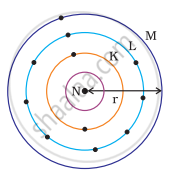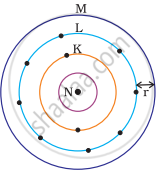Advertisements
Advertisements
प्रश्न
Nanometer unit is used to measure atomic radius.
पर्याय
Right
Wrong
उत्तर
Nanometer unit is used to measure atomic radius- Wrong
APPEARS IN
संबंधित प्रश्न
Give the trends in atomic size on moving down the group.
Why is the size of neon greater than fluorine?
Which is greater in size an atom or an anion?
The following questions refer to the Periodic Table.
What happens to the atomic size of elements moving from top to bottom of a group?
Supply the missing word from those in the brackets:
If an element has seven electrons in its outermost shell then it is likely to have the ______ (largest/ smallest) atomic size among all the elements in the same period.
Arrange the following as per the instruction given in the bracket.
Mg, Cl, Na, S, Si (increasing order of atomic size)
The changes in the properties of elements on moving from left to right across a period of the Periodic Table. For the property, choose the correct answer.
The atomic size:
Atomic radius is expressed in the unit _______.
While going from top to bottom in a group the atomic radius _______.
Which of the following is the correct order of atomic size?
Which of the following gives the correct increasing order of the atomic radii of O, F and N?
Which one of the following depict the correct representation of atomic radius(r) of an atom?
|
(i) |
(ii) |
|
(iii) |
(iv) |
An element X (atomic number 17) reacts with an element Y (atomic number 20) to form a divalent halide.
- Where in the periodic table are elements X and Y placed?
- Classify X and Y as metal (s), non-metal (s) or metalloid (s)
- What will be the nature of oxide of element Y? Identify the nature of bonding in the compound formed
- Draw the electron dot structure of the divalent halide
Atomic number of a few elements are given below
10, 20, 7, 14
- Identify the elements
- Identify the Group number of these elements in the Periodic Table
- Identify the Periods of these elements in the Periodic Table
- What would be the electronic configuration for each of these elements?
- Determine the valency of these elements
- Electropositive nature of the element(s) increases down the group and decreases across the period
- Electronegativity of the element decreases down the group and increases across the period
- Atomic size increases down the group and decreases across a period (left to right)
- Metallic character increases down the group and decreases across a period.
On the basis of the above trends of the Periodic Table, answer the following about the elements with atomic numbers 3 to 9.
- Name the most electropositive element among them
- Name the most electronegative element
- Name the element with smallest atomic size
- Name the element which is a metalloid
- Name the element which shows maximum valency.
The diagram below shows part of the periodic table.
- Which elements would react together to form covalent compounds?
- Between the two elements W and Z, which will have a bigger atomic radius? Why?

Arrange the following in order of increasing radii:
N, O, P
Explain your choice.
Give reason for the following:
The size of a Cl− ion is greater than the size of a Cl atom.




